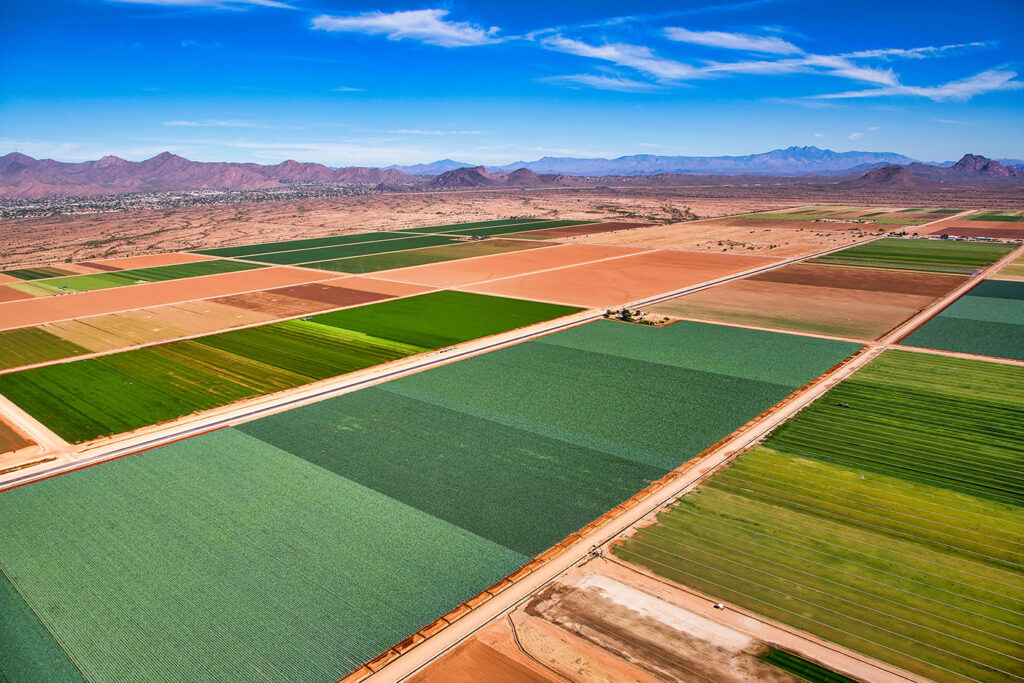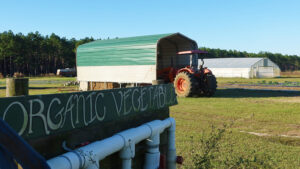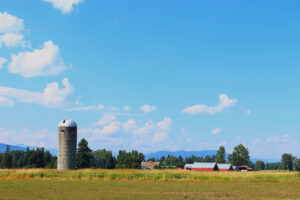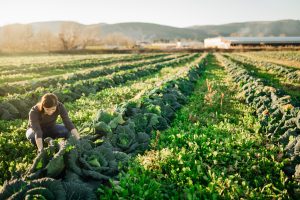In recent decades, foreign investors have bought more than 35 million acres of U.S. farmland worth $62 billion — about 2.7% of all privately held land nationwide, an area larger than New York state. And foreign investors continue to buy, according to USDA.
Some American farmers view foreign investment as beneficial, expanding markets and access to capital. Others view it as a threat to national security, food system resiliency and land access.
“Allowing this practice to continue would lead to the creation of a Chinese-owned agricultural monopoly and pose an immediate threat to U.S. national security and food security,” Newhouse said. The legislation is moving through Congress.
Newhouse is right that China is a big player. According to 2018 USDA data, Chinese investment in the agricultural sector has grown tenfold in a decade.
But most of China’s investments have been in the meat sector and the Midwest. Investment often takes a different shape in the West. In four Western farm states — California, Oregon, Washington and Idaho — China doesn’t even make it onto the list of top 10 investors.
So, who is buying farmland in the West, and what are their intentions?
Big players in the West are from Canada, Europe and Japan. Top investments include timber, tree fruit, winegrapes, manufacturing and processing, real estate development and renewable energy.
Tracking buyers
To uncover which countries are investing in American soil and why, the Capital Press requested a database of public records from USDA through the Freedom of Information Act.
The database is called the Agricultural Foreign Investment Disclosure Act, created in response to a law Congress passed in 1978 requiring foreign buyers to report transactions.
The database covers the years 1900 through 2019, although records are patchy prior to 1978. USDA is still compiling the 2020 list, said Amanda Heitkamp, USDA spokeswoman.
The database tracks investments in cropland, pastureland, forestland and “other” farmland.
According to USDA staff, outside investments are on the rise. Filings show foreign holdings of American farmland increased by 141% between 2004 and 2019.
This, experts say, is a conservative estimate. That’s because, although the 1978 law required foreigners to report land purchases, the requirement is not enforced.
Joe Maxwell, [president of Farm Action Fund], a group that advocates on behalf of small family farmers against corporate behemoths, said he believes the database, though useful, “woefully underreports” the number of foreign investments.
“It’s just the tip of the iceberg,” he said. “We believe what’s being reported is just a thimbleful of what’s actually out there.”
The only way to accurately trace all foreign holdings, land use experts say, would be to piece together records from every county assessor’s office in the nation — a mammoth project.
“It’s just really difficult to track,” said Jim Johnson, land use and water planning coordinator at the Oregon Department of Agriculture.
Changing hands
Farmland, once in someone’s hands, doesn’t always stay there.
Although USDA reports foreigners hold an interest in about 35 million acres, that’s assuming every foreigner who ever bought farmland held onto it. And that’s just not the case.
The database, cross-referenced with public business filings and sales records, reveals that many foreign investors have sold farmland they once held. Dozens of foreign owners have dissolved businesses, sold land to domestic or international buyers, gone bankrupt or experienced foreclosure.
Behind the numbers
Foreign investment comes in many flavors: from individuals, corporations, institutions, associations, estates, trusts and partnerships.
Tracking names recorded in USDA’s database, the Capital Press called and emailed dozens of foreign buyers across the West, revealing a tapestry of people and stories.
Some buyers have big names, like the Haub Brothers Enterprise Trust, which is associated with Erivan Haub, a German grocery store magnate whose trust bought thousands of acres of Washington farmland.
Other buyers have straddled continents, like a young British farmer running a biogas business and operating farm properties in both Oregon and the United Kingdom.
Still others have been immigrants headed West to build a dream, like a Dutch flower grower who, with his wife and baby in tow, took out loans to build a bulb business.
Oregon
Foreign buyers have purchased 1.2 million acres of Oregon farmland — roughly 7.5% of the state’s farm acreage, according to the 2017 U.S. Census of Agriculture.
Top investors are from Canada, Luxembourg, Sweden, Portugal and the U.K. Investors from the first three countries have invested mainly in timber, investors from the latter two in wind and solar power.
Reflecting microclimates and the character of the land, investments vary from county to county. Gilliam and Umatilla counties, where foreigners have bought the largest number of parcels, have mainly seen renewable energy developments. Polk County has seen timber and wine investments.
Whether foreign investment is good or bad is a matter of disagreement among Oregon farmers.
Solar power on farmland is especially controversial, and groups including the Oregon Farm Bureau and 1,000 Friends of Oregon have raised alarms that large solar developments, though important, don’t belong on high-value soils.
“We’re constantly fighting the misconception that agricultural land is vacant land. It’s not,” Kathryn Jernstedt, president of Friends of Yamhill County, told the Capital Press this summer.
Farmers view other investments more favorably.
Before the 1970s, Oregon’s wine industry was virtually nonexistent. But as pioneers started making high-quality wine, it grabbed the attention of international investors.
The first French family to buy an Oregon vineyard was the Drouhin family, which has been making wine since 1880 in the Burgundy region of France.
After visiting Oregon, Robert Drouhin and his daughter, Veronique, decided to buy land in 1987.
“The Oregon wine community was so welcoming to the family,” said David Millman, the company’s CEO and president. “This wonderful, respected family investing in Oregon of all places was this huge, huge boost — a sort of validation.”
Today, more than a dozen European companies own Oregon vineyards.
Critics, including Maxwell of [Farm Action Fund], said there should be a distinction between control and investment. Investment is good, he said — a foreign entity investing dollars and receiving a percentage of profits. But Maxwell said foreigners should not hold land or management positions.
Most leaders in Oregon’s wine industry disagree.
“While foreign investment has caused some concern within the Oregon wine community, overall, it has been viewed as a positive,” said Sarah Murdoch, spokeswoman for Oregon Wine Board. “Our wines are now recognized as being world-class.”
“These newcomers,” she said, treat Oregon growers with respect and have brought “new energy, new ideas and greater national and international marketing capacity.”
Oregon’s legislature has made no laws restricting foreign ownership of private farmland.
Washington
Foreign buyers have purchased even more farmland in Washington: 1.5 million acres. Top investors are from Canada, the U.K., the Netherlands, Portugal and France.
Canadians mainly invested in timber, tree fruit and berries; investors from the U.K. are focused on wind, solar and timber. Portugal and France are in wind power. The Netherlands mainly holds land as part of a pension plan favoring conservative investments.
Investments vary by county.
In Whatcom County, where foreigners have bought more than 294 parcels, buyers have mainly invested in manufacturing, oil and gas, trucking and wind power. Most oil and gas investments came from BP, a British company that runs the Cherry Point Refinery near Bellingham. It’s the largest oil refinery in Washington state.
Yakima County has big investments in tree fruit, wind power and hops.
European entrepreneur John I. Haas and the next generation of his family invested heavily in the American hop industry, buying a few thousand acres in Yakima from the 1930s to the 2010s for hop production, processing and breeding. Today, John I. Haas Inc. is a member of the BarthHaas Group, a partnership between German and American companies and a leading global supplier of hop products and services.
Many beer industry leaders say foreign investment has helped boost the state’s reputation.
But other farmers are concerned.
Frank Lyall, an orchardist in Grandview, said acquisitions in the tree fruit industry worry him.
Lyall said he’s concerned wealthy foreign investors will outbid young and beginning American farmers for land. It doesn’t help, he said, that investors are also better poised to navigate Washington’s complex regulatory environment.
“We’ve lost that deal where you have generations of people staying in farming,” said Lyall. “If people think they don’t have the opportunity to own land and farm for themselves, they might look for another career. A lot of young people don’t want to be part of a giant conglomerate.”
Maxwell, of [Farm Action Fund], agrees.
“The real problem is not just that (investors are) outbidding the farmer. It’s that they’re paying more for the land than the actual production value of the land, which drives up overall land prices,” said Maxwell.
Washington state does not ban foreign ownership, but in 2016, the legislature passed a law requiring foreign businesses to register with the secretary of state.
California
California’s top five investors are from the U.K., Netherlands, Japan, France and Canada.
U.K. buyers have mainly invested in timber, wine, real estate and water rights. The Netherlands has invested mainly for its pension plans in cattle, olives, oil and gas. Japan has focused on real estate investments, rice and tree fruit. France is in wind power and winegrapes. Canada has channeled dollars into real estate, wine and nut trees.
Each county, once again, has tasted a different flavor of investment.
Kern County, where foreigners have purchased more than 311 parcels, has seen investors buy land for oil and gas development through subsidiaries of international giants such as Royal Dutch Shell, headquartered in the Netherlands.
Kern County has also seen investments in almonds, nurseries and renewable energy.
Fresno County, ranking second for the largest number of parcels owned by foreigners, has seen investments in wine, almonds, cattle and gas and oil development.
California’s Central Valley is becoming a major hub for renewable energy.
“The Central Valley could become a mega-center for energy production and storage,” said Richard Waycott, president and CEO of the Almond Board of California.
Waycott said he doesn’t necessarily see that as a bad thing. It reflects the reality, he said, that farmers are selling off drought-prone, less-productive farmland and consolidating operations in more productive regions.
Under California law, only citizens or those on the path to citizenship can lease public land. But regarding private land, officials told the Capital Press there are no regulations.
Idaho
Of the four Western states, Idaho has the least foreign investment: 122,598 acres.
The biggest five investors have been from France, the U.K., Germany, Canada and Liechtenstein.
French investors, as usual, are involved in wind power. The U.K. has focused on manufacturing, “dude” ranches and cropland. Germany and Canada have bought land mainly for chemical, seed and fertilizer production. Liechtenstein is primarily in real estate.
Caribou County in southeastern Idaho has the most foreign-owned parcels.
One of the biggest investments in Caribou County came from NU-West Industries Inc., a fertilizer and ag chemical company owned by Nutrien, an international corporation based in Canada.
Another large Caribou County investment was from P4 Production LLC in 2018. P4, a scientific research and development company, is a subsidiary of Monsanto Co. The German company Bayer AG bought St. Louis-based Monsanto in 2018.
In nearby Teton County, investments have a different purpose. There, west of Wyoming’s Grand Teton National Park and Jackson Hole, lies farmland that often sells for upwards of $15,000 per acre, according to property tax records. The average 2021 U.S. cropland value is $4,420 per acre, according to USDA’s National Agricultural Statistics Service.
According to filings, Teton County has seen tremendous investment from international buyers acquiring the valuable real estate.
Idaho currently has no laws limiting foreign purchases of private farmland.
The future
Foreign investment in the West takes a different shape than in the Midwest.
China’s investment strategy in the Midwest and the East is clear, said Maxwell of [Farm Action Fund]. A Chinese company, WH Group, first purchased meat processing infrastructure such as Smithfield Foods, the world’s largest pork producer. Then it bought cropland — Midwestern wheat, corn and soybean acres — to feed those hogs.
In the West, different themes emerge, including an interest in renewable energy, high-value perennial crops, real estate — and more recently, land purchased for its water rights.
So, what’s next? Though farmers in the West differ in their opinions on whether foreign investment is bad, good or a mix, most with whom the Capital Press spoke said something should be done.
Watch Congress, Maxwell said, where debates about China have opened the much broader conversation about foreign investment as a whole.
Change, he said, may be on the way.





